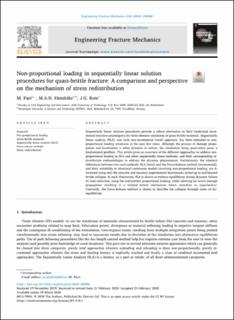| dc.contributor.author | Pari, Manimaran | |
| dc.contributor.author | Hendriks, Max | |
| dc.contributor.author | Rots, Jan G. | |
| dc.date.accessioned | 2021-04-08T08:53:35Z | |
| dc.date.available | 2021-04-08T08:53:35Z | |
| dc.date.created | 2020-04-20T11:14:29Z | |
| dc.date.issued | 2020 | |
| dc.identifier.citation | Engineering Fracture Mechanics. 2020, 230:106960 1-22. | en_US |
| dc.identifier.issn | 0013-7944 | |
| dc.identifier.uri | https://hdl.handle.net/11250/2736784 | |
| dc.description.abstract | Sequentially linear solution procedures provide a robust alternative to their traditional incremental-iterative counterparts for finite element simulation of quasi-brittle materials. Sequentially linear analysis (SLA), one such non-incremental (total) approach, has been extended to non-proportional loading situations in the past few years. Although the process of damage propagation and localisation is often dynamic in nature, the simulation being quasi-static poses a fundamental problem. This article gives an overview of the different approaches to address non-proportional loading in SLA and other sequentially linear methods, and their corresponding redistribution methodologies to address the dynamic phenomenon. Furthermore, the inherent differences between two such methods: SLA (total) and the Force-Release method (incremental), and their suitability to structural continuum models involving non-proportional loading, are illustrated using real-life concrete and masonry experimental benchmarks tested up to and beyond brittle collapse. In each illustration, SLA is shown to enforce equilibrium during dynamic failure by load reduction, using the intermittent proportional loading, while allowing for active damage propagation resulting in a relaxed failure mechanism which manifests as snap-back(s). Contrarily, the Force-Release method is shown to describe the collapse through states of disequilibrium. | en_US |
| dc.language.iso | eng | en_US |
| dc.publisher | Elsevier | en_US |
| dc.rights | Navngivelse 4.0 Internasjonal | * |
| dc.rights.uri | http://creativecommons.org/licenses/by/4.0/deed.no | * |
| dc.title | Non-proportional loading in sequentially linear solution procedures for quasi-brittle fracture: A comparison and perspective on the mechanism of stress redistribution | en_US |
| dc.type | Peer reviewed | en_US |
| dc.type | Journal article | en_US |
| dc.description.version | publishedVersion | en_US |
| dc.source.pagenumber | 1-22 | en_US |
| dc.source.volume | 230:106960 | en_US |
| dc.source.journal | Engineering Fracture Mechanics | en_US |
| dc.identifier.doi | 10.1016/j.engfracmech.2020.106960 | |
| dc.identifier.cristin | 1807092 | |
| cristin.ispublished | true | |
| cristin.fulltext | preprint | |
| cristin.qualitycode | 1 | |

